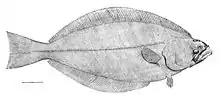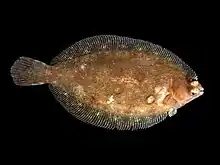Pleuronectidae
Pleuronectidae, also known as righteye flounders, are a family of flounders. They are called "righteye flounders" because most species lie on the sea bottom on their left sides, with both eyes on their right sides.[1] The Paralichthyidae are the opposite, with their eyes on the left side. A small number of species in Pleuronectidae can also have their eyes on the left side, notably the members of the genus Platichthys.[2][3]
Their dorsal and anal fins are long and continuous, with the dorsal fin extending forward onto the head. Females lay eggs that float in mid-water until the larvae develop, and they sink to the bottom.[4]
They are found on the bottoms of oceans around the world, with some species, such as the Atlantic halibut, Hippoglossus hippoglossus, being found down to 2,000 m (6,600 ft). The smaller species eat sea-floor invertebrates such as polychaetes and crustaceans, but the larger righteye flounders, such as H. hippoglossus, which grows up to 4.7 m (15 ft) in length,[5] feed on other fishes and cephalopods, as well.
They include many important commercially fished species, including not only the various fish called flounders, but also the European plaice, the halibuts, the lemon sole, the common dab, the Pacific Dover sole, and the flukes.
The name of the family is derived from the Greek πλευρά (pleura), meaning "rib" or "side", and νηκτόν (nekton), meaning "swimming".
Classification
The family has four subfamilies:
- Pleuronectinae – 27 genera and about 60 species in the Northern Hemisphere (includes Eopsettinae, Hippoglossinae, Hippoglossoidinae, and Lyopsettinae recognized by some as valid subfamilies)
- Paralichthodinae – one species off southern Africa
- Poecilopsettinae – three genera and about 20 species in tropical and subtropical oceans
- Rhombosoleinae – nine genera and about 20 species in the Southern Hemisphere
In some classifications, the last three subfamilies are raised to the level of families.[6][7]
 Atlantic halibut, Hippoglossus hippoglossus
Atlantic halibut, Hippoglossus hippoglossus Greenland halibut, Reinhardtius hippoglossoides
Greenland halibut, Reinhardtius hippoglossoides American plaice, H. platessoides
American plaice, H. platessoides Witch, Glyptocephalus cynoglossus
Witch, Glyptocephalus cynoglossus Lemon sole, Microstomus kitt
Lemon sole, Microstomus kitt Common dab, Limanda limanda
Common dab, Limanda limanda English sole, Parophrys vetulus
English sole, Parophrys vetulus Pacific sand sole, Psettichthys melanostictus
Pacific sand sole, Psettichthys melanostictus Deepwater dab, Poecilopsetta beanii
Deepwater dab, Poecilopsetta beanii Black flounder, Rhombosolea retiaria
Black flounder, Rhombosolea retiaria
See also
- Bothidae, the lefteye family of flounders
References
- Froese, Rainer, and Daniel Pauly, eds. (2012). "Pleuronectidae" in FishBase. October 2012 version.
- Eschmeyer W.N.; Herald, E.S.; and Hammann, H. (1983). A Field Guide to Pacific Coast Fishes. Peterson Field Guides. ISBN 978-0618002122
- Muus, B.J; Nielsen, J.G.; Dahlstrøm, P.; Nyström, B.O. (1991). Sea Fish. ISBN 978-8790787004
- Chapleau, Francois & Amaoka, Kunio (1998). Paxton, J.R. & Eschmeyer, W.N. (eds.). Encyclopedia of Fishes. San Diego: Academic Press. p. 224. ISBN 0-12-547665-5.
- "Hippoglossus hippoglossus". Fishbase. Rainer Froese and Daniel Pauly (editors). 5 June 2009. Retrieved 2009-06-22.
{{cite web}}: CS1 maint: others (link) - J. A. Cooper & F. Chapleau (1998). "Monophyly and intrarelationships of the family Pleuronectidae (Pleuronectiformes), with a revised classification". Fish. Bull. 96 (4): 686–726.
- "Pleuronectidae". Integrated Taxonomic Information System. Retrieved 2 April 2006.




